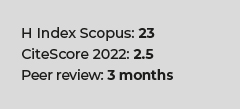Iodine concentration in urine and salt consumption in women between 12 to 49 years of age in Peru
DOI:
https://doi.org/10.17843/rpmesp.2015.322.1615Keywords:
Iodine, Iodine deficiency, Nutritional surveys, EpidemiologyAbstract
Objectives. To determine the concentrations of iodine in urine and salt intake in women between 12-49 years of age in Peru. Materials and methods. An observational and cross-sectional study was performed. During 2012 and 2013, the study included women aged between 12-49 years living in Peruvian households selected through a probabilistic, stratified and multistage sample. The determination of iodine in urine was performed based on the Sandell-Kolthoff reaction spectrophotometry. The qualitative evaluation of iodine salt was performed by Yoditest and the quantitative by volumetric analysis. Processing was performed using complex samples with weights. Medians, interquartile range and percentiles were obtained. Results. The median urinary iodine levels in the participants was 250.4 ug/L. The regions with elevated median urinary iodine levels were: Moquegua (389.3 ug/L); Tacna (320.5 ug/L); Madre de Dios (319.8 ug/L), and Ucayali (306.0 ug/L); while Puno (192.9 ug/L); Piura (188.1 ug/L) and Tumbes (180.5 ug/L) had medians within ranges recommended by the WHO. The median urinary iodine in pregnant women was 274.6 ug/L (IQR: 283 ug/L).82.5% of the samples had iodine salt ≥30 ppm and 1.9% had values of 0 ppm. Conclusions. The median urinary iodine in Peruvian women is higher than recommended by the WHO and the majority of the samples had adequate iodine concentrations according to WHO recommendations.Downloads
Download data is not yet available.
Downloads
Published
2015-06-19
Issue
Section
Original Article
How to Cite
1.
Tarqui-Mamani C, Sánchez-Abanto J, Alvarez-Dongo D, Jordán-Lechuga T, Fernández-Tinco I. Iodine concentration in urine and salt consumption in women between 12 to 49 years of age in Peru. Rev Peru Med Exp Salud Publica [Internet]. 2015 Jun. 19 [cited 2024 Apr. 19];32(2):252-8. Available from: https://rpmesp.ins.gob.pe/index.php/rpmesp/article/view/1615



























